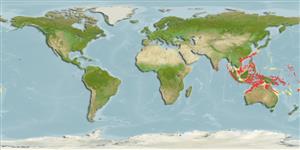>
Perciformes/Serranoidei (Groupers) >
Epinephelidae (Groupers)
Etymology: Epinephelus: Greek, epinephelos = cloudy (Ref. 45335); kupangensis: Name from Latin suffix '-ensis', denoting place or locality, is appended to the locality of Kupang, Indonesia, the center of the Timor Sea fishery that provided the first author with the holotype and several paratypes..
Environment: milieu / climate zone / depth range / distribution range
Ekologi
marina revassocierade; djupintervall 50 - 300 m (Ref. 111063). Tropical
Indo-West Pacific: Indonesia (Timor Sea), Timor-Leste, Philippines, Taiwan, and Fiji.
Size / Vikt / Age
Maturity: Lm ? range ? - ? cm
Max length : 39.1 cm SL hane/ej könsbestämd; (Ref. 111063)
Short description
Bestämningsnycklar | Morfologi | Morfometri
Taggstrålar i ryggfenan (totalt) : 11; Mjukstrålar i ryggfenan (totalt) : 15 - 17; Taggstrålar i analfenan: 3; Mjukstrålar i analfenan: 8. This species is distinguished from its Indo-Pacific congeners by having the following characters: lateral line scales 46-49 (vs. at least 51 in all species except E. areolatus, E.
bilobatus, E. bleekeri, E. bontoides, E. chlorostigma, E. faveatus, E. howlandi, E. longispinis, E. macrospilos, E. maculatus, E. merra, E. miliaris, E. polyphekadion, E. quoyanus, E. timorensis, E. trimaculatus), round caudal fin (vs. emarginate to truncate caudal fin in E. areolatus, E. bleekeri, E. chlorostigma, E. geoffroyi, E. timorensis), no distinct spots over most of head and body (vs. numerous distinct spots - not dots - over most of head and body in E. bilobatus, E. bontoides, E. faveatus, E. howlandi, E. longispinis, E. macrospilos, E. maculatus, E. merra, E. miliaris, E. polyphekadion, E. quoyanus, E. trimaculatus) (Ref. 111063).
This fish is part of a large, deep-water drop line fishery, which focuses its efforts on banks and promontories of shelf habitat in depths of up to 350 m (Ref. 111063).
Life cycle and mating behavior
Maturities | Reproduktion | Spawnings | Egg(s) | Fecundities | Larver
Tucker, S.J., E.M. Kurniasih and M.T. Craig, 2016. A new species of grouper (Epinephelus; Epinephelidae) from the Indo-Pacific. Copeia 104(3):658-662. (Ref. 111063)
IUCN Red List Status (Ref. 130435)
Threat to humans
Harmless
Human uses
Verktyg
Special reports
Download XML
Internet-källor
Estimates based on models
Phylogenetic diversity index (Ref.
82804): PD
50 = 0.5000 [Uniqueness, from 0.5 = low to 2.0 = high].
Bayesian length-weight: a=0.01175 (0.00571 - 0.02419), b=3.04 (2.88 - 3.20), in cm total length, based on LWR estimates for this Genus-body shape (Ref.
93245).
Trofisk nivå (Ref.
69278): 3.8 ±0.6 se; based on size and trophs of closest relatives
Resiliens (Ref.
120179): Mellan, lägsta populationsfördubblingstid 1,4-4,4 år (Preliminary K or Fecundity.).
Fishing Vulnerability (Ref.
59153): Moderate vulnerability (38 of 100).
